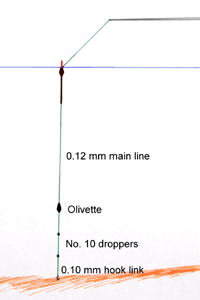The basic pole rig is to have a bulk that is 90% or more of the shot load of the pole float plus one or two tiny dropper shot below the bulk weight. The bulk weight is traditionally an elongated pear shaped weight called an ‘olivette’. These were formerly made from lead but are now made from either brass or tungsten. The idea is that the streamlined olivette gets the bait down very quickly and sets the float with just the tiny dropper shot affecting the float bristle and helping to detect bites.
What are ‘olivettes’?
Olivettes come in two types; some are threaded on the line and held in position with a tiny shot each end or by a bristle jammed in the silicone tube that lines the hole. Those without a central hole are held onto the line by two tiny pieces of float silicone tube using the pegs at each end of the olivette. The alternative to using an olivette is to make a bulk from a bunch of shot. For small floats, this could be several no. 8 shot but bigger floats will need larger shot such as no. 6 or 4, or even BBs or AAAs. 
What is this rig best for?
This type of bulk rig is ideal for fishing hard on the bottom, and choosing a float that takes 0.1 grams per foot of depth is a good starting point especially for water that is less than eight feet deep. For depths in excess of this choose a float that takes one gram for nine feet of water and add 0.25 for each extra foot of water i.e. 11 foot would warrant 1.5 grams etc. In adverse conditions, you may need to fish even heavier than this. This rig is ideal for stillwaters and slow moving rivers. For faster flowing rivers it can also be used but you will want a heavier float with a thicker bristle.
Don’t be afraid to experiment
Experiment with how far you want the olivette from the hook; a good starting point is to have it about a quarter of the way up from the hook i.e. if fishing four feet deep then place the olivette about a foot from the hook. Match the size of the dropper shot to the bristle thickness; extra fine bristles mean no. 13 shot droppers, medium ones no. 10 & 11, and thick ones no. 8s.
Choosing A Float
For stillwater pole fishing a simple pole float with a pear shaped body is ideal. Choose one with a bristle that you’ll be able to see at the range you will be fishing, depending on light conditions. A black bristle may show up better if the water appears white.
River pole fishing is better tackled with a pole float that is an inverse pear shape – fat end up.
Shallow water is best tackled with relatively short stemmed floats; longer stemmed floats are more stable and ideal for deeper water.
Plumbing the depth
Plumbing the depth is easy when pole fishing; simply attach a plummet and lower gently into the water. Take care to check the depth in different parts of the swim.
About the Rigs Page
- The Rigs Page is a library of features to illustrate all those rigs that will be useful to both beginners and experienced anglers.
- The rigs can be extremely simple and well known, or very complicated and little known, it doesn’t matter providing they make some kind of sense and have a really practical application.
- It could be a standard running leger rig that a beginner will appreciate seeing in pictures, or a very complicated anti-eject carp rig that the experienced carp angler would like to see.
- If you wish to contribute a rig to this section please remember that the emphasis is on illustration rather than words. Good line drawings are fine in the absence of photographs. Please send to graham@fishingmagic.com










